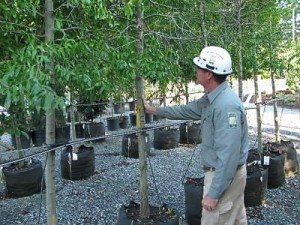
By pushing against the stem with the root ball secured we can gauge root development.
Purchasing high quality trees is not as easy as going to a big box store and selecting the cheapest plants available. Doing so will ensure less than optimal results. I’ve examined thousands of trees and many tree ailments can be traced directly back to improper selection. Mistakes made during tree selection are not easily corrected.
Searching for High Quality Trees
The structure of the tree must be good. Unless you are intentionally looking for a multi-trunked plant, a high quality specimen will have a single, strong central leader that has many evenly-spaced lower branches. The trunk should have good taper and be reasonably straight without any severe bends. Branches should not be crossing or rubbing and should be less than two-thirds the diameter of the trunk.
The foliage should be healthy, shoot growth should be good, and the plant should be free of disease and harmful insects. The trunk should be inspected for any injuries to the bark. Remove any trunk wrap if necessary to inspect the trunk. High quality trees do not have bark injuries. There is a thin layer of cells just beneath the bark called the cambium that is responsible for generating the trees vascular system. If the cambium is damaged, growth can be stunted and the trunk can be easily infected
All pruning cuts that have been made should be outside the branch collar. You can usually see the branch collar as a slightly swollen area at the trunk-branch juncture. This is important because the trunk has chemical protection tactics that can be easily breeched if the branch collar is damaged. Flush cuts will severely weaken the trees defenses against fungal, viral, and bacterial pathogens.
Finally the root system must be inspected. The root collar or root flare is where the topmost roots meet the trunk. If no widening of the trunk is visible, excavate the soil to see where the roots are attached to the trunk. The topmost roots should be no lower than one inch from the surface of the soil. Do not purchase trees that have their root collar buried too deeply.
If a tree has been in a container for too long, the roots will circle around the outside container wall. Do not purchase a tree with severe circling roots. They will eventually girdle the tree and after a few years growth, the tree will fail at the root collar. The roots should be a healthy light color.
Buying high quality trees will ensure your new additions reach their full potential. Your landscape will look better, increase in value, and be an important component of the urban forest.
